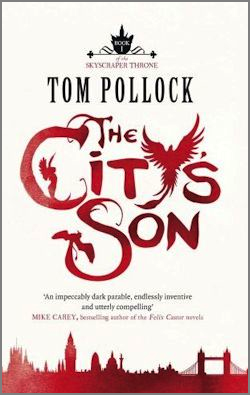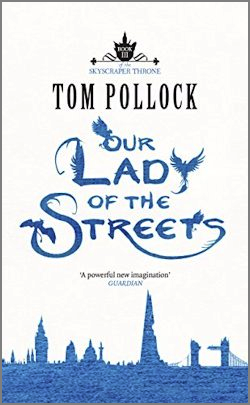There was always something special about Beth Bradley; something which went beyond her quick wit, her evident intelligence. Wasn’t so long ago she was one among many—a badly-behaved teenager suffering through school, as exceptional individuals like Beth tend to—yet even then she was set apart by her street art; by graffiti which came to life because of her partnership with Pen, who’d append poetry to her pictures, turning still images into stories. Stories of the city.
Stories such as those Tom Pollock has told over the course of The Skyscraper Throne: an inventive and affecting urban fantasy saga which comes full circle with the release of Our Lady of the Streets. Be prepared to bid a bittersweet goodbye to Beth and her best friend, then… but not before they’ve had one last adventure together. An adventure as incredible as it is desperate; as tragical as it is magical.
Why? Because Beth Bradley is dying.
You could say she’s city-sick. About to bow out because she has become London, and London is all but lost. Since the manifestation of Mater Viae’s mirror image, the very streets have become fevered—a sweltering mass of metal and glass.
Most of the locals have legged it, luckily. But the infection is spreading. London is “an organic city,” all of a sudden, “capable of growing hundreds of miles in only a few weeks—and bringing its sickness to everything it touches.” Everything… and everyone.
Pitiful in the face of its progress, the remnants of the resistance:
Beth looked at them, and the sheer worry on their faces pushed her wounded pride back into her chest. She thought about the ache in her muscles and the swelling in her joints; she thought about the prickling fever racing under her skin, and the way that the world blurred when she turned her head too fast. She thought about the slow, hollow ache in her stomach. She hissed in frustration.
Her frustration, I’m afraid, only grows greater, as the faith of those who have followed in her footsteps fails. Understandable given that “the girl on whom all their hopes depend as a challenger to this demonic entity is a rotten apple-skin’s thickness from the grave herself,” to wit, the part Pen plays in the resistance’s next offensive proves pivotal.
Recently freed from the city behind the mirrors, Beth’s bestie has been empowered by the awful things that have happened to her. She’s stronger than she was; wiser as well. Wise enough to know that they are “woefully overmatched in a battle against an Urban Goddess,” and so, behind Beth’s back she goes—to find allies of any shape, any size.

She even asks for the assistance of the barbed beast which came this close to killing her in The City’s Son. Happy to have a host, the Wire Mistress obliges. Added to the paltry lot in the pot, her power hardly levels the playing field, but it does mean that Pen can give Beth rather more than moral support as the resistance plans one last stand—because there may yet be a way to end this.
All they have to do is mercy kill a city.
Whatever the result, readers of the series will be pleased as can be to see Beth and Pen together again in the attempt. It’s true that both girls are dramatically different from the innocents we met at the outset—their sacrifices have cost them awfully—but however changed they are, in some ways they remain the same playful pair we fell for in the first. Pollock even gives them a chance to scrawl words and pictures on a wall. One more for the road, you know?
Crucially, the devastating development of the series’ central characters continues in Our Lady of the Streets, undaunted by all the plot, of which there’s a joyous lot. Props to the author for packing so much action into the narrative—action he handles here better than ever, and it was pretty brilliant to begin with—and especially for separating said storms courtesy a couple of calm moments. Moments in which Beth and Pen can breathe; can be. The book is at its absolute best during these.
It follows, I’m afraid, that the pace proves a touch tempestuous at times, particularly in the beginning. Conclusions usually have so much to do—so much catch-up to communicate to returning readers—that they start woefully slowly. Our Lady of the Streets occupies the other end of the spectrum, such that finding one’s footing takes quite some time.
Meanwhile, the monsters: always among the highlights of a Tom Pollock novel, and though there aren’t a great many new creations on display—excepting a certain river spirit—the best baddies from the other books are back. So: stone statues, streetlight creatures and sewermanders. “Cranes and wolves and wire and water.” Gutterglass returns; as does Johnny Naptha and the creepy Chemical Synod. In totality, one of the finest rogue’s galleries in all urban fantasy.
The City’s Son, for its part, marked a strong start, and the emergence of an improbably promising new voice in the genre. The Glass Republic—an ingenious inversion of the expectations set by said—proved Tom Pollock was no one-hit wonder. With Our Lady of the Streets, he goes three for three. I couldn’t have asked for a more satisfying finale. And sorry as I am to say farewell to Beth and Pen, I’m even more excited to see what this awesome author sets his sights on next.
Our Lady of the Streets is available August 7th from Jo Fletcher Books (UK)
Niall Alexander is an extra-curricular English teacher who reads and writes about all things weird and wonderful for The Speculative Scotsman, Strange Horizons, and Tor.com. He’s been known to tweet, twoo.










